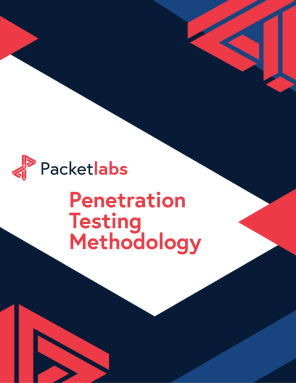Black-Box, Grey-Box, and White-Box Penetration Testing
- Black-Box Penetration Testing
- Grey-Box Penetration Testing
- White-Box Penetration Testing
- A Summary of Black-Box vs Grey-Box vs White-Box Penetration Testing
- Which Approach is Right for Your Organization?
- Understanding the Value of Penetration Testing
- Deciding Which Testing Approach Fits Your Objectives
- The Hidden Costs of Choosing the Wrong Testing Method
- Integrating Penetration Testing into a Continuous Security Program
- The Role of Penetration Testing in Zero Trust and Compliance Strategies
- Choosing Packetlabs as Your Penetration Testing Partner
Would you like to learn more?
Download our Pentest Sourcing Guide to learn everything you need to know to successfully plan, scope, and execute your penetration testing projects.
You've heard of black-box, grey-box, and white-box penetration testing, but you're not sure what the differences are or which test will give you the best level of protection against malicious cyberattacks.
When it comes to selecting the type of testing, several of the most commonly asked questions that arise include:
Why is it recommended to provide and use credentials from the client when testing an application?
Does the penetration testing organization need to be whitelisted during the engagement?
Shouldn’t the testing engagement focus on replicating an external hacker trying to penetrate all defenses to evaluate our implemented security accurately?
To help answer those questions, it is best to look at the pros and cons of each of the three penetration testing types: black-box, grey-box, and white-box.
Black-Box Penetration Testing
In a black-box engagement, the tester is not granted any access to the applications or networks. The tester must perform reconnaissance to obtain the sensitive knowledge needed to proceed.
This type of testing is the most realistic simulation of a cyberattack. However, it also requires a great deal of time and has the greatest potential to overlook a vulnerability that exists within the internal part of a network or application.
In addition, many defensive tools exist within networks to help prevent an existing vulnerability from being exploited. Some web browsers now have settings to circumvent an attack even if a weakness still exists. All that may be required to exploit that vulnerability is a variation of settings or a connection from a different browser version.
Just because a configuration prevents the vulnerability from being found or exploited does not necessarily mean the vulnerability does not exist or is actually being mitigated. It only means that some outside force is buffering the result. This can result in a false sense of security that may be exploited at a later time by someone who has more time to explore this attack surface more thoroughly.
Grey-Box Penetration Testing
With grey-box testing, the tester is granted some internal access and knowledge that may come in the form of lower-level credentials, application logic flow charts, or network infrastructure maps. This can simulate an attacker who has already penetrated the perimeter and has limited internal access to the network.
Starting with some background information and low-level credentials achieves a more efficient and streamlined approach. This saves time on the reconnaissance phase, allowing the consultants to focus their efforts on exploiting potential vulnerabilities in higher-risk systems rather than attempting to discover where these systems may be found.
In addition, some types of vulnerabilities can only be discovered by looking at the source code or configuration settings. A tester with no prior knowledge would likely never stumble across these less common issues.
White-Box Penetration Testing
White-box testing allows the tester to have complete open access to all applications and systems. The tester is granted high-level privileges access to the network and can view source code.
White-box testing aims to identify potential weaknesses in various areas such as logical vulnerabilities, potential security exposures, security misconfigurations, poorly written development code, and lack of defensive measures. This type of assessment is more comprehensive, as both internal and external vulnerabilities are evaluated from a 'behind the scenes' point of view that is unavailable to typical attackers.
Once again, because so much time is required to review all aspects of the system thoroughly, white-box testing is generally reserved for high-risk systems or those that process sensitive data.
A Summary of Black-Box vs Grey-Box vs White-Box Penetration Testing

Which Approach is Right for Your Organization?
A penetration test aims to identify potential vulnerabilities in your systems before an attacker does. The level of access and knowledge granted to the tester will determine how comprehensive and accurate the test results will be.
Defining the concerns you would like to resolve is essential to designing a customized approach that will effectively meet the necessary security requirements and result in the most value from your penetration testing investment.
Packetlabs' team of highly skilled and OSCP-certified ethical hackers customize every engagement to ensure the most thorough penetration test possible. We understand that not every architecture or application fits into a predefined box and will require an adaptive testing methodology to develop a solution that works best for your organization.
Automated testing accounts for only 5% of what we do. The other 95% consists of manually simulated real-life attacks, so whether you are looking for a black-box, grey-box, or white-box assessment, Packetlabs has the experience and expertise to help you secure your system and prevent costly data breaches.
Understanding the Value of Penetration Testing
Before deciding which testing methodology to choose, it’s crucial to understand what penetration testing is designed to achieve. Penetration testing is not just about finding vulnerabilities: it’s about simulating how real attackers operate and identifying the chain of weaknesses that could lead to compromise. By approaching your environment from the perspective of an adversary, ethical hackers can demonstrate both the likelihood and impact of a breach.
While vulnerability scans or automated tools can detect common weaknesses, penetration testing goes further, revealing gaps in configurations, authentication, and business logic that automation cannot detect. The right type of test— whether it be black-box, grey-box, or white-box— depends on your organization’s objectives, environment maturity, and risk tolerance.
Deciding Which Testing Approach Fits Your Objectives
Selecting between black-box, grey-box, and white-box testing depends heavily on what your organization aims to achieve:
Black-box testing is ideal for organizations seeking to simulate real-world external attacks and measure the effectiveness of perimeter defenses.
Grey-box testing works best for evaluating how an attacker might move laterally after initial access; ideal for hybrid cloud environments or businesses with complex user roles.
White-box testing delivers the deepest technical insight and is particularly effective for compliance validation, secure development lifecycle reviews, and testing critical internal systems.
Organizations that operate under strict regulatory frameworks (such as finance, healthcare, or energy) may benefit from combining approaches. A hybrid testing model offers both external realism and internal depth, providing a more complete picture of risk.
The Hidden Costs of Choosing the Wrong Testing Method
Selecting the wrong testing approach can lead to wasted resources and missed vulnerabilities. For example, opting for a black-box test when your primary risks stem from insider threats or misconfigured internal systems may leave significant blind spots. Similarly, running only white-box tests without testing external entry points might overlook exposed services or web-facing misconfigurations.
Beyond security gaps, an ineffective testing approach can result in compliance failures, delayed remediation cycles, and costly retesting. According to IBM’s Cost of a Data Breach Report 2025, organizations that performed regular penetration tests and vulnerability scanning reduced their breach impact by 38% on average, compared to those relying solely on automated tools.
Integrating Penetration Testing into a Continuous Security Program
Penetration testing shouldn’t be treated as a one-time event: it should be part of an ongoing cycle of assessment, remediation, and validation. Continuous penetration testing and Red Teaming both allow organizations to identify new attack surfaces as systems evolve and threat actors change tactics.
Modern organizations deploy code continuously, adopt new cloud services, and onboard vendors at record speeds, all of which expand the attack surface. Implementing continuous testing ensures that new vulnerabilities introduced during change cycles are caught early.
In fact, organizations with recurring penetration testing programs detect and contain breaches 92 days faster than those without, according to Ponemon Institute research.
The Role of Penetration Testing in Zero Trust and Compliance Strategies
With frameworks like Zero Trust Architecture (ZTA) and compliance standards such as ISO 27001, SOC 2, and NIST 800-53 gaining traction, penetration testing has become an essential validation tool. It verifies whether access controls, segmentation, and least-privilege principles are effectively implemented.
For CISOs and compliance officers, penetration testing provides measurable proof of security posture improvement—critical for demonstrating due diligence to auditors, regulators, and insurers. Beyond compliance, these assessments build organizational resilience and help justify cybersecurity investments at the executive level.
Choosing Packetlabs as Your Penetration Testing Partner
At Packetlabs, our ethical hackers go beyond automated testing by conducting 95% manual assessments aligned with MITRE ATT&CK and OWASP frameworks. Whether you need black-box, grey-box, or white-box testing, our methodologies are designed to uncover hidden risks before adversaries do.
Our engagements focus on real-world impact, demonstrating how vulnerabilities can be chained to achieve privilege escalation or data compromise.
With CREST accreditation and SOC 2 Type II attestation, Packetlabs delivers trusted testing services that exceed industry standards and align with your organization’s long-term security goals.
Contact Us
Speak with an Account Executive
Interested in Pentesting?

Penetration Testing Methodology
Our Penetration Security Testing methodology is derived from the SANS Pentest Methodology, the MITRE ATT&CK framework, and the NIST SP800-115 to uncover security gaps.
Download Methodology
Pentest Sourcing Guide
Download our Pentest Sourcing Guide to learn everything you need to know to successfully plan, scope, and execute your penetration testing projects.
Download GuideFeatured Posts

November 26 - Blog
ChatGPT and Other AI Platforms May Be Used To Craft Malicious Code
While many AI tools create opportunities for innovation, others are using them to create malicious code. Here's what you need to know about the rise of AI code by ChatGPT and other AI chatbots.

November 14 - Blog
The Rise of Hackers in APAC and Its Implications for Australia
While APAC is steadily emerging as a global innovation hub, the region's massive digitization post-pandemic has outpaced its cybersecurity preparedness and has led to a spike in breaches.

November 06 - Blog
9 AI Enabled Cybersecurity Tools in 2025
Discover 5 AI-powered cybersecurity tools that support red teaming, threat detection, and vulnerability discovery efforts.







